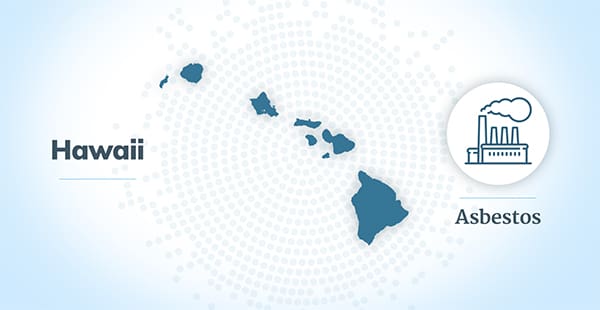Asbestos Use in Hawaii
Asbestos does not occur naturally in Hawaii. Workers and residents in Hawaii were most often exposed to asbestos through workplaces, jobsites and imports. Homes, schools and other public buildings built before 1980 were also known sources of asbestos exposure.
Shipyards were a major source of asbestos exposure for many Hawaiian workers. This includes the well-known Pearl Harbor Naval Base. Other industries with known exposure risks include agriculture, manufacturing, military and utilities.
Hawaii Asbestos Statistics
Hawaii residents still face potential health risks from asbestos exposure and mesothelioma. Key facts and statistics about asbestos and mesothelioma in Hawaii from 1999 to 2020 include:
- Hawaii ranked 45th for the most mesothelioma cases in the United States at 185.
- Hawaii ranked 46th for the most mesothelioma deaths in the United States at 154.
- The counties of Hawaii, Honolulu and Maui had the highest numbers of mesothelioma deaths in the state.
Patients in Hawaii can get expert mesothelioma treatment at the University of Hawai’i Cancer Center in Honolulu. Dr. Michele Carbone and Dr. Haining Yang are two experienced mesothelioma doctors at this center. In 2022, they discovered new life-saving methods to prevent and treat mesothelioma.
Anyone in Hawaii with mesothelioma or other asbestos-related conditions may qualify for compensation. Mesothelioma lawyers in Hawaii can help victims of asbestos exposure determine their legal options and file lawsuits for them.
Occupational Asbestos Use in Hawaii
With no natural asbestos deposits on the islands, all asbestos exposure in Hawaii comes from commercial activity. This includes occupational asbestos use at workplaces and jobsites and handling imported goods.
Among those most at risk were workers in the agriculture and shipping industries, as well as power plant employees. Military members in Hawaii also were at high risk of asbestos exposure. Those working on, in or near ships were especially vulnerable.
Many public buildings in Hawaii built before 1980 were made with asbestos-containing materials. This includes government buildings, hotels and schools. Asbestos products were also used in home construction.
In 2023, asbestos was found in one of the Hawaii State Department of Health (DOH) buildings in Honolulu. The building in question was built in 1961. The DOH is monitoring air quality through regular testing.
Deadly wildfires swept through Hawaii in 2023, mainly on the island of Maui. These wildfires may have exposed Maui residents to asbestos and other harmful toxins, including arsenic and lead. These contaminants were found in the ash and debris.
The State of Hawaii has an Asbestos Program to protect residents and the environment from asbestos exposure.
Shipping
The shipping industry has long formed an important part of Hawaii’s economy. The state has an extensive maritime history that dates back to the early 19th century and early Polynesian settlers. This industry also has a long history of asbestos use.
In the early 19th century, fishing and whaling became lucrative businesses, particularly whaling for whale bones and oil. At one point, up to 400 ships visited Lahaina on the island of Maui each year to go whale hunting.
In the early 20th century leading up to World War II, shipping remained a key industry. Today, Port Hawaii is the state’s commercial harbor system. It is based out of Honolulu Harbor on the island of Oahu.
Nearly 99% of the islands’ imported goods come through this harbor. The amount of asbestos found on ships made the shipping industry a key source of asbestos exposure for many residents and workers in Hawaii.
Agriculture
In the agricultural industry, farming equipment has been known to contain asbestos materials. This machinery is used to plant, harvest and process crops. Farm mechanics and other farm laborers who fix or work with this equipment have an elevated risk of asbestos exposure. This includes farmers who perform their own maintenance work.
Of particular concern in Hawaii is the sugarcane industry. Sugarcane burning is thought to make harvesting more efficient, but it does produce sugarcane smoke. The Hawaii State DOH requested a formal investigation. It was concerned about the chronic health issues of sugarcane workers.
The National Institute for Occupational Safety and Health (NIOSH) investigated two companies: the Hawaiian Commercial & Sugar Company and the Hamakua Sugar Plantation. They took air samples from machinists and mechanics who worked for these sugarcane companies. Some of the samples contained asbestos.
Military
From 1930 to 1980, all branches of the U.S. military used asbestos products on their bases and ships. The mineral was also found in their vehicles and weapons. Military personnel, civilian workers, veterans and their families were at risk of serious health issues. The health threats included mesothelioma and other asbestos-related diseases.
Located on the island of Oahu, Hawaii, Pearl Harbor is one of the most widely known U.S. Navy bases. As of 2010, the Pearl Harbor base is now the Joint Base Pearl Harbor-Hickam, shared by the Navy and the U.S. Air Force.
Other Hawaiian islands house various U.S. Army facilities. This includes the Tripler Army Medical Center and the Wheeler Army Airfield, both of which are in Honolulu. The U.S. Coast Guard also operates two significant bases: Base Honolulu and Station Maui. Camp H.M. Smith, a U.S. Marine Corps base in Honolulu, is known to be built with asbestos-containing construction materials.
Power Plants
Power plants used asbestos to insulate and protect power-generating machinery from high temperatures. Insulation that contained asbestos was often added to boilers, pipes and turbines. This put power plant workers at a high risk of asbestos exposure.
Lawsuits were filed against several Hawaiian utility companies after the 2023 wildfires on the island of Maui. The companies include Hawaiian Electric Industries, Hawaiian Electric Company, Hawai’i Electric Light Company and Maui Electric Company. The lawsuits say they caused the fires because they didn’t manage their electrical infrastructure.
Ash, debris and dust from the Lahaina Fire released known carcinogens into the air. This included:
- Arsenic
- Asbestos
- Benzene
- Carbon dioxide
- Carbon monoxide
- Lead
- Nitrogen oxide
Any level of exposure to asbestos and other toxic airborne contaminants puts Hawaiian residents’ health at risk.
Manufacturing
The Vermiculite of Hawaii plant in Honolulu operated from 1954 – 1983. Vermiculite is a naturally occurring mineral that can be found across the United States.
From the early 1920s until 1990, vermiculite was mined and processed in Libby, Montana. At the time, the mines in Libby produced approximately 80% of the world’s vermiculite. In 1999, the U.S. Environmental Protection Agency (EPA) added the Libby mines to the Superfund list. The reason was asbestos contamination.
The U.S. Agency for Toxic Substances and Disease Registry (ATSDR) later discovered that Libby vermiculite was shipped across the country for processing, including to Vermiculite of Hawaii. In 2005, the ATSDR discovered the plant had processed asbestos-contaminated Libby vermiculite.
Any Vermiculite of Hawaii plant workers present during this time frame may have been exposed to asbestos. These employees may also have exposed their families via secondary asbestos exposure. Hawaii residents who lived close to the plant may also be at risk.
Asbestos Shipyards in Hawaii
Around the country, shipyards are recognized as frequent sites of asbestos exposure. Hawaii has maintained a rigorous shipping industry throughout its history. This has allowed for an increased risk of asbestos exposure at its harbors and shipyards.
Pearl Harbor Naval Shipyard
Pearl Harbor Naval Shipyard became a U.S. Navy base and shipyard in 1908, serving as an important operations hub for many years. In 1941, the Imperial Japanese Navy Air Service led a surprise attack against Pearl Harbor. It became a front line of defense during the Asia-Pacific War during World War II.
From 1943 until the end of the war in 1945, more than 5,500 ships spent time at the base’s facilities. Shipyard workers who both worked and lived at Pearl Harbor may have faced high levels of asbestos exposure. As such, Pearl Harbor workers have an increased risk of developing mesothelioma, asbestos lung cancer and other asbestos-related diseases.
Today, the Pearl Harbor Naval Shipyard serves as the United States’ foremost facility for fleet maintenance and repair.
Pacific Shipyards International
Pacific Shipyards International launched its first shipyard in Honolulu in 1944 toward the end of World War II. This private company provided shipbuilding and repair services to the U.S. Navy. It currently preserves and repairs military and commercial ships. Shipyard workers were often exposed to asbestos through shipbuilding materials and imported goods.
Asbestos Exposure in Hawaiian Cities
Hawaiians may have experienced asbestos exposure at jobsites in major cities and on smaller islands. For instance, Honolulu is home to many industries that commonly used asbestos, including shipbuilding and power generation. Workers in these fields may have encountered asbestos products.
Hawaiians risked asbestos exposure in other cities, as well. An experienced mesothelioma lawyer can help residents with an asbestos-related illness determine where exposure may have occurred.
Asbestos Risks at Other Hawaiian Jobsites
Outside of Hawaii’s major cities, asbestos exposure has been found at other jobsites throughout the islands. Residents and workers in smaller towns throughout Hawaii may also have been exposed to asbestos through commercial buildings, imported goods, schools and workplaces.
, Hawaii Jobsites Where Asbestos Exposure Occurred
- Alexander & Baldwin
- Alexander and Baldwin
- Alexander Young Building
- Aloha State Sales Company
- American Factors Limited
- American Sanitary Laundry Company
- American Sugar Company
- Bechtel Power Corporation
- C and C, Inc.
- C. Brewer & Company
- California and Hawaiian Sugar Company
- California Packing Corporation
- Castle & Cooke, Inc.
- Chevron Hawaii
- Chevron USA Inc.
- Craig & Company
- Dillingham Petroleum Corp
- Dole Food Company
- Electric Automobile Company
- Erra Plantation
- Ewa Plantation Company
- Ewa Sugar Mill
- Gear Lansing and Company
- Grove Farm
- Grove Farm Company
- Grumman Ecosystems Corporation
- H Hackfield and Company
- H R Worthington
- H. Hackfeld and Company
- H.R. Worthington
- Haiku Sugar Company
- Hakalau Plantation Company
- Halstead Brothers
- Hawaii Electric Light Company
- Hawaii Water Works LLC
- Hawaiian Agricultural Company
- Hawaiian Agricultural Company
- Hawaiian Agricultural Company
- Hawaiian Can Products
- Hawaiian Comm. and Sugar Company
- Hawaiian Commercial & Sugar Company Ltd.
- Hawaiian Commercial and Sugar Company
- Hawaiian Dredging Construction Company
- Hawaiian Electric
- Hawaiian Electric Company
- Hawaiian Electric Company Inc.
- Hawaiian Electric Kahe Power Plant
- Hawaiian Electric Light Company
- Hawaiian Electric Waiau Power Plant
- Hawaiian Equipment Company
- Hawaiian Linen Supply
- Hawaiian Pineapple Company
- Hawaiian Telephone Annex
- Hawaiian Tuna Packers, Ltd.
- Hilo Coast Processing Company Ltd
- Hilo Drywall Company, Inc.
- Hilo Electric Company
- Hilo Electric Light Company
- Hilo Electric Light Company
- Hilo Electric Power and Refrigerator Company
- Hilo Sugar Company
- Honokaa Sugar Company
- Honolulu Brewing & Malting Co. Ltd.
- Honolulu Gas Company (Hawaii Gas)
- Honolulu Iron Works
- Honolulu Laundry Company, Ltd.
- Honolulu Planing Mill
- Honolulu Plantation Company
- Honolulu Plantation Company
- Honolulu Rapid Transit and Land Company
- Hutchinson Sugar Plantation Company
- Hydro-Blast, Inc.
- Kaeleku Sugar Company Ltd
- Kahe Power Plant
- Kahuku Plantation Company
- Kaiser Cement & Gypsum
- Kalihi Pumping Station
- Kanoehe Rauch Company
- Kauai Electric Company, Ltd.
- Kekaha Sugar Company
- Kekaha Sugar Company, Ltd
- Kikei Plantation
- Kilauea Sugar Plantation Company
- Kohala Sugar Company
- Kohala Sugar Company
- Kohala Sugar Company
- Koloa Sugar Company
- Laie Plantation
- Lambert-Cole, Inc.
- Laupahoehoe Sugar Company
- Laupahoehoe Sugar Company
- Laupahoehoe Sugar Company
- Lewers & Cooke
- Libby, McNeill & Libby
- Marconi Wireless Telegraph Company of America
- Mason Contractors Association of Hawaii
- Matson Container Station
- Matson SS Lines
- Maui Electric Company
- Maui Electric Company
- Maui Electric Company Ltd.
- Maui Land & Pineapple Company Inc.
- McBryde Sugar Company
- McBryde Sugar Company
- Naval Fleet Air Base
- Naval Smoke Abatement Facility
- Navy Department Bureau of Supplies and Accounts
- Nuuanu Memorial Park & Mortuary
- Oahu Ice and Electric Company
- Oahu Sugar Company
- Olaa Sugar Company
- Olokele Sugar Company Ltd.
- Onomea Sugar Company
- Owens-Corning Fiberglas
- Paauhau Sugar Plantation Company
- Pearl Harbor Naval Shipyard
- Pearl Harbor Naval Shipyard
- Pepeeko Sugar Company
- Pioneer Mill Company
- Pioneer Mill Company Ltd
- Puna Sugar Company, Ltd
- R R Hind Hawai Plantation
- Reciprocity Sugar Company
- Schofield Barracks
- Standard Oil
- Tesoro Hawaii
- The Plantation Inn – Lahaina
- The Queen’s Medical Center
- Troy Laundry Machinery Company, Ltd.
- U.S. Naval Shipyard
- United States Naval Station
- Von Hamm-Young Company
- W.A. Ramsay, Ltd.
- W.A. Ramsey, Ltd.
- Waiahole Water Company
- Waiakea Mill
- Waiakea Steam Plant
- Waialua Agricultural Company
- Waialua Agricultural Company Station
- Waialua Plantation
- Waialua Plantation
- Waialua Sugar Mill
- Waiau Power Plant
- Wailuku Plantation
- Wailuku Sugar Company
- Waimanalo Sugar Company
- Waimea Sugar Company
- Yamada Transfer







